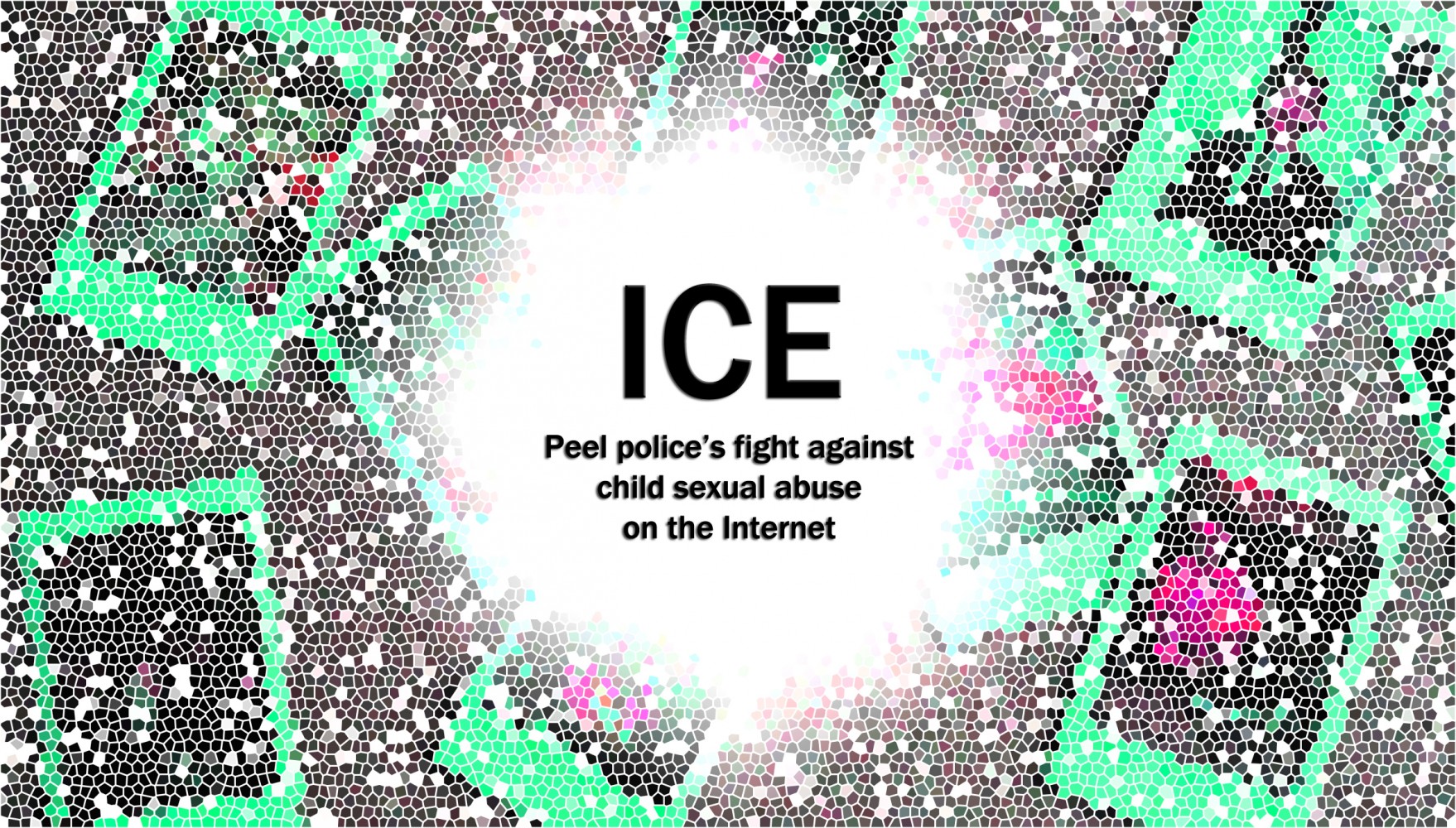
Parents, please read this: Peel police ICE unit facing an alarming surge of child exploitation online
Warning: This story contains graphic details pertaining to sexual assault, child sexual exploitation and rape which may upset some readers.
Sitting down, detective Mark Gordon pushes his hands over the table, his palms grating against the wood veneer as he reaches for his pile of papers and lines up the corners of the stack. He sets his shoulders, folds his hands. Behind him, the blue and yellow logo of the Peel Regional Police Special Victims Unit jumps off the wall beneath strong fluorescent lights.
His posture and the clench of his jaw exude the strength of a police veteran. Over a 21-year career he’s put in time with Peel’s uniform patrol, the street crimes unit, the central robbery unit, the provincial weapons unit, the Intelligence Bureau, and even Internal Affairs investigating complaints of harassment and misconduct within the department.
But what he deals with now, staring at image after image of child sexual abuse, cleary impacts him in a different way.
“I’ve experienced nothing like this before,” he says.
Gordon is the officer in charge of the Peel police Internet Child Exploitation Unit, or ICE unit, and each and every day, he and his fellow officers are dealing with a rising tide of child sexual abuse material. Police agencies and academics have moved away from labelling these images as “child pornography” as to avoid confusing this vile material with legal, adult pornography.
A recent study by the Internet watchdog Virtual Global Taskforce (VGT) has found a startling increase of this material accessible across the globe. In Peel Region, Gordon and his officers are dealing with much of the same, both in terms of volume of images and video, and those committing the crimes of viewing it, or worse, creating it themselves with children in Peel.
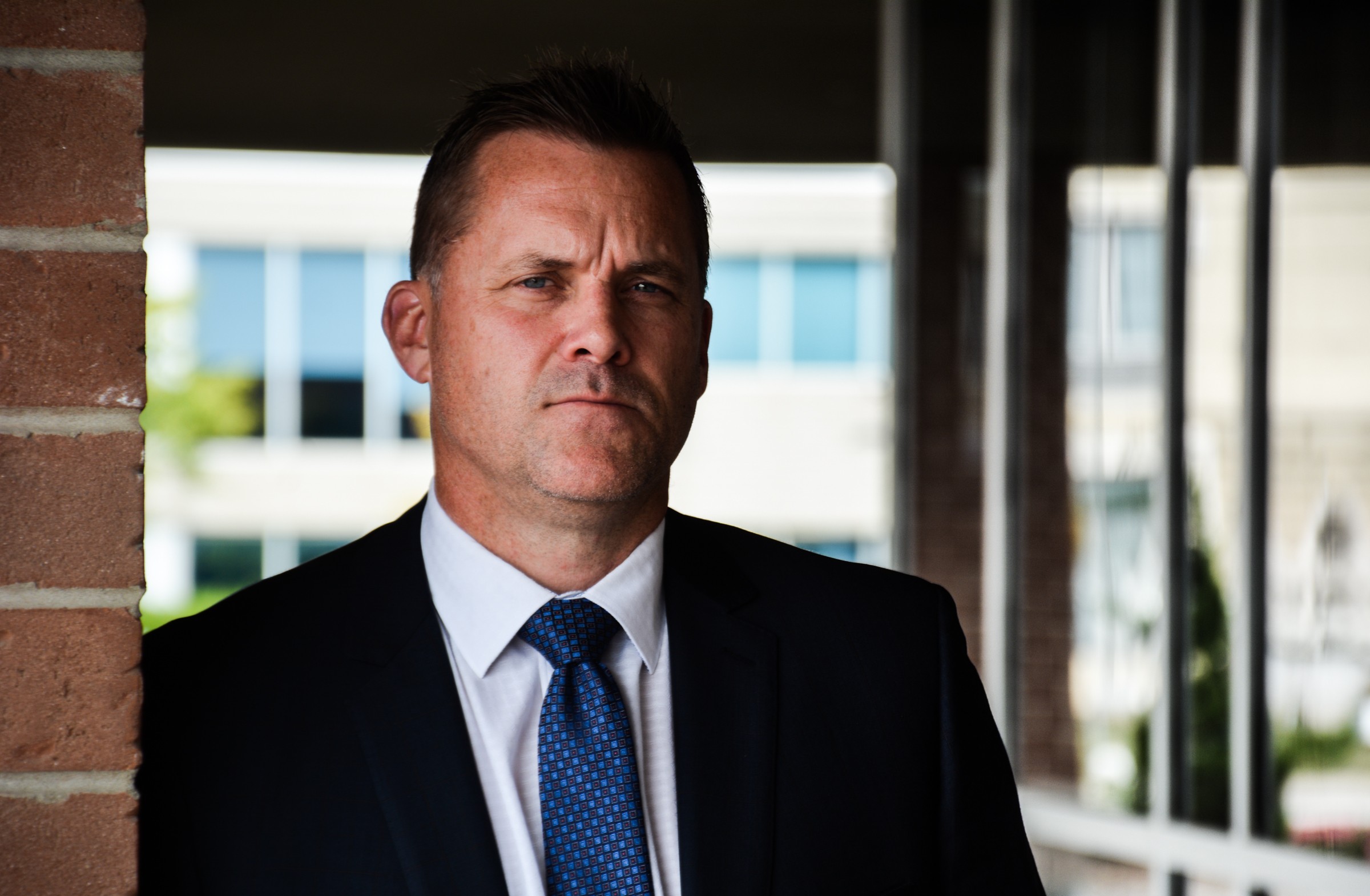
Det. Mark Gordon, the officer in charge of Peel Police's Internet Child Exploitation (ICE) Unit.
As the calendar turned over from 2018 to 2019, many within the Peel Regional Police were hoping for a fresh start in the new year, a chance to take a deep breath following the violent year that was 2018, a year that saw startling increases in many types of the most troubling crimes, including homicides, shootings, stabbings, and assaults.
The relief never came. The past 10 months have been just as bloody as the last with Peel on pace to surpass totals for shootings, stabbings, and, potentially, homicides.
Lost among the headline grabbing gunfire and gang activity is the disturbing work of officers in Peel’s ICE unit, many of whom mostly operate in the digital realm, their time spent on keyboards staring into a screen rather than in a squad car or at a crime scene.
However, this group of seven investigators — eight including Gordon, the lead detective — is also dealing with an increasingly troubling reality, one usually ignored by the daily crime headlines and news coverage.
Over the last five years, Mississauga and Brampton have registered a 332 percent increase in sex crimes against children, rising from 38 crimes in 2014 to 164 in 2018, nearly three times the increase observed across Ontario, where such violations have increased 128 percent in five years, from 952 in 2014 to 2,176 last year.
While not all of these charges relate directly to the work of the ICE unit, most of them do, and the workload streaming across their desks only continues to increase.
Tips from the National Child Exploitation Coordination Centre (NCECC) about either child sexual exploitation material being viewed or originating in Peel police’s jurisdiction have increased 543 percent since 2015, ballooning from 28 reports that year to 180 in 2018. When The Pointer met with Gordon in September, Peel had already surpassed the previous year's total with 184 reports so far in 2019.
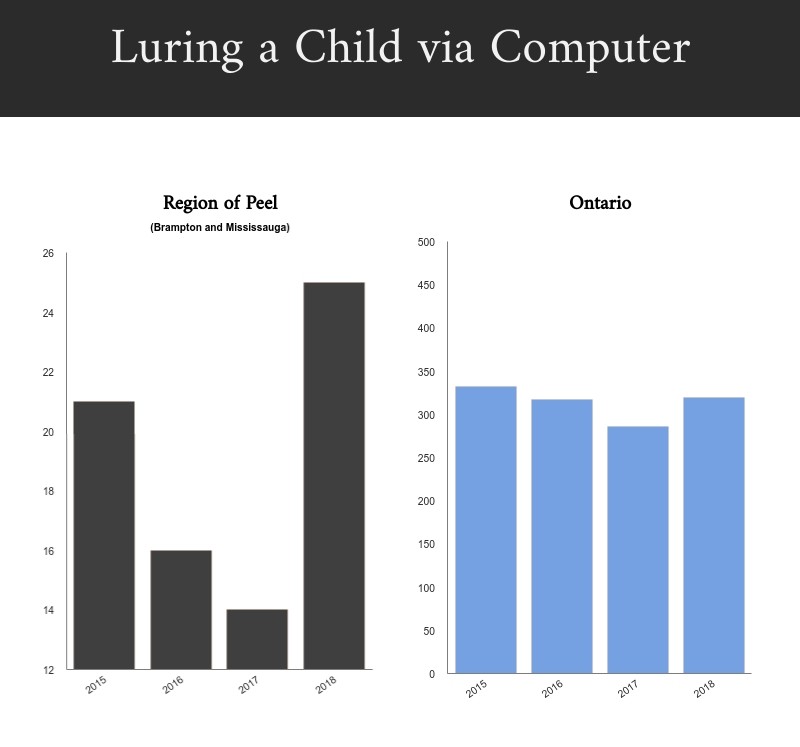
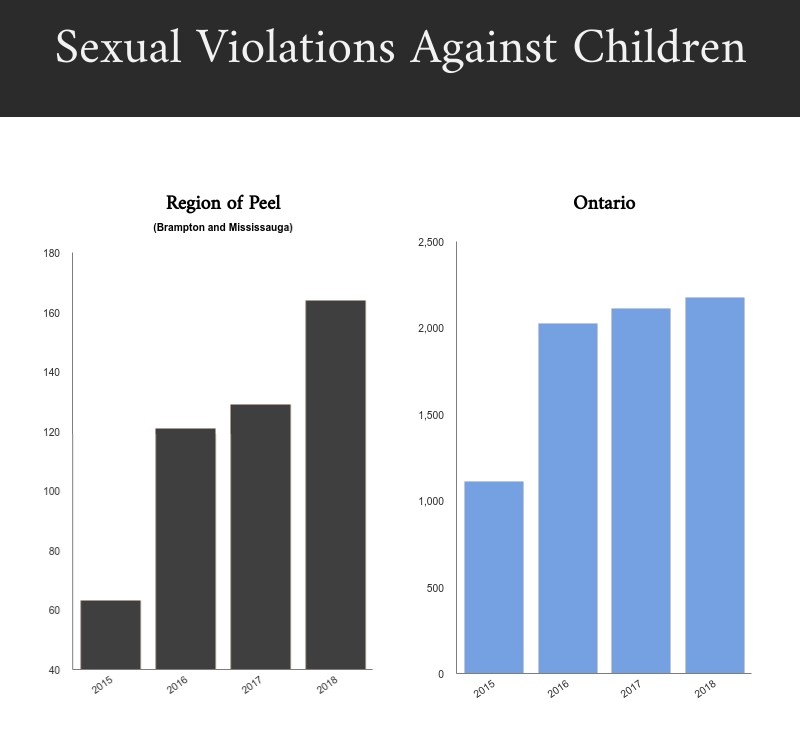
It’s a disturbing increase, Gordon says, and it’s only one avenue through which the ICE unit receives reports about abusive material.
Each image or video investigated represents a life irrevocably altered, each victim a child who is more likely to follow a path to substance abuse, depression and suicide.
The volume and frequency is staggering.
“We’re talking about daily,” Gordon says. “Some of the material we’ve previously viewed and seen, some of it is new material. With new material comes new victims and we’re doing everything we can to identify those children who are in need of protection.”
The reports from the NCECC are called Cybertip reports, named after the website (Cybertip.ca) through which the public can provide information to the RCMP about the existence of sexually exploitative material on the internet. Peel police also receive domestic reports from callers in Peel Region and also get notices from the Canadian Border Services Agency when local residents are caught with images or material involving child exploitation in their possession.
“This kind of crime doesn’t know boundaries and doesn’t know barriers. It can travel worldwide, the internet has provided that resource for it,” Gordon says.
This reality allows for abusers to hide in internet chat rooms — or in corners of the dark web for the more nefarious offenders — and interact with children through social media and other popular online communities.
Just over a year ago, police in New Jersey arrested 24 men, including one police officer, through a week-long sting, who were trying to lure children over social media sites or online games like Fortnite.
Here in Peel, instances of child luring increased 79 percent between 2017 and 2018, and this year has seen a number of arrests at the hands of the ICE unit.
Over the course of 20 days in February, Peel arrested three men for either possession of child sexual abuse imagery or luring.
On February 1, a 22-year-old Mississauga man was charged for possessing material involving child sexual exploitation. Police learned he worked at three separate daycare facilities in the region as part of a co-op placement, was a referee for minor hockey in the GTA and was trying to become an early childhood educator.
Not a week later, a 56-year-old man from Guelph was charged with child luring after trying to arrange sex with someone he believed to be under 16. A similar charge was laid against a 39-year-old man in Peel on Feb. 20.
Similar arrests were made in June, August and September, with all cases now before the courts.
In many cases that lead to arrest, the under-age person the offender believes he’s communicating with is in fact an undercover ICE officer.
Gordon confirmed this is a common tactic used by the Peel ICE unit, but was understandably scarce on the details.
“We do have online personnel proactively taking an approach to this as well. I won’t get too much into the details of that,” he said.
At the same time, this is not news to many in the public who have a modicum of knowledge about police work, and it most certainly isn’t news to the offenders committing the crime, who are generally more savvy about efforts to put them behind bars than the general public.
“It’s self-preservation; any crime group that you talk about with respect to knowledge is probably more aware of the crime that they’re committing (and what police are doing) than the average community,” Gordon says.
In chat rooms populated by pedophiles, they celebrate their crimes, share best practices for avoiding detection, such as new internet privacy measures, and even encourage one another to create new abusive material.
A shuttered website known as the Love Zone, previously had 30,000 members, all of whom were urged to share abusive images in order to remain in good standing on the site.
According to the recent VGT study, one site with over 18,000 members is dedicated solely to infants and toddlers (also called pre-verbal children, meaning they can’t report the abuse). One online forum dedicated to discussing the abuse of children had exceeded over 23 million hits, while another site requires members to upload three minutes of video and two images each month as a form of payment. Many of these sites are hidden behind labyrinths of links, only accessed by the right combination of clicks on a given site, otherwise the site appears perfectly normal.
“There is a general lack of political and societal awareness and understanding of the issue of online child sexual exploitation,” the VGT study concludes. “This results in a lack of proper training and funding to combat this crime-type, as well as a severe lack of long-term support for victims. Notably, accurate and consistent information may be absent, resulting in a perception that the scale of the threat is less than it actually is.”

Founded in 2003, the VGT is an international organization made up of police agencies, non-governmental groups and industry partners dedicated to protecting children from sexual exploitation.
With partners in Canada (RCMP), Europe (Eurpol) and other countries that are known to be hotbeds for child sexual exploitation, like the Philippines, the taskforce has global reach, and is able to identify and track the changing nature of online sexual exploitation of children.
On Nov. 1, the VGT released its latest Environmental Scan of child sexual exploitation on the internet to identify challenges, threats and new trends being observed by police institutions across the world.
The study received responses from 50 different organizations, including police, across nine different countries. It makes for disturbing reading.
When it came to the volume of child sexual exploitation material online, 70 percent of organizations reported an increase. In particular, the National Centre for Missing and Exploited Children in the United States received 18.4 million reports in 2018, a 1,572 percent increase from the 1.1 million reports only four years before.
In Canada, the National Child Exploitation Crime Centre saw a 566 percent increase in the number of reports received between 2015 and 2018.
There’s been a 57 percent increase in the number of registered web domains showing images of child exploitation, according to WeProtect Global Alliance.
The Internet Watch Foundation, an organization dedicated to finding and reporting child sexual abuse online, says that every four minutes they access a new webpage, and every seven minutes that webpage shows a child being sexually abused.
Along with becoming more frequent, the abuse is also getting worse. Technology and internet security has allowed forums dedicated to this abuse to flourish, allowing offenders to communicate directly with one another, pushing each other to perform worse and worse atrocities.
“One law enforcement respondent noted that increased communication between child sex offenders online has increased the pressure to produce new child sexual exploitation material, with this incitement resulting in an escalation of offending,” the VGT reads.
Perhaps most horrendous is the now emerging trend of livestreaming of child sexual abuse. According to WeProtect Global Alliance, the prevalence of this type of livestreaming is expected to grow 15 times between 2016 and 2021 and account for 13 percent of Internet video traffic by that time.
“Child sex offenders are now able to pay for and direct the live sexual abuse of children while hidden in private homes and internet cafes without having to leave their own homes…As such, overseas perpetrators can request certain sexual acts to take place in advance of the abuse, or while its underway.”
As disturbing as the numbers are, it’s unfortunately only a glimpse at the true size of the problem.
“These numbers only represent a fraction of offences being perpetrated every year as many offenders remain undetected and victims remain unidentified,” the VGT study reads. “While child sexual abuse is not a new phenomenon, the internet has transformed the threat into a global issue. Although cooperation amongst countries is increasing, there are still many barriers to providing a streamlined global response.”
Those barriers include the increasing access and attention being paid to internet security. A double-edged sword in that privacy is certainly important for individuals accessing the internet, but it is also allowing offenders to evade police while they undertake their crimes using such technologies at Virtual Private Networks (VPNs) which redirect a user’s connection to a private server, allowing their location and other information to remain hidden from investigators.
On the frontline, Det. Gordon explains that in Peel, the police have been forging relationships with Internet Service Providers (ISPs) in order to both find offenders and remove content when it’s discovered.
“We’re actively seeking to have material removed from the Internet that is specific to child sexual abuse material. It’s a difficult process, as you know how quick things can go viral,” Gordon tells The Pointer. “It’s very difficult because the speed of which this can travel, anything can travel, on the internet, but we’re doing our due diligence to remove that material from online.”
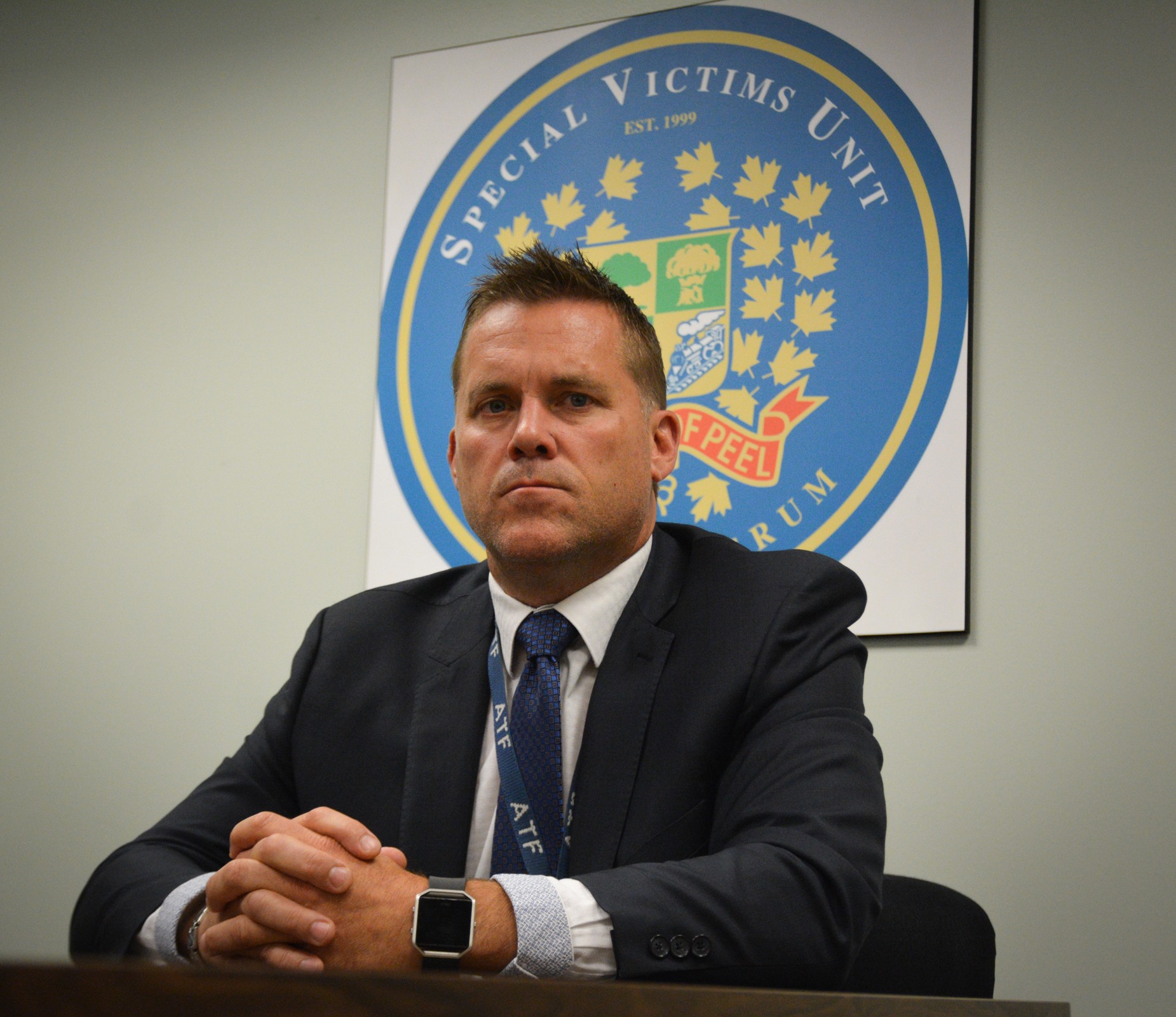
Det. Gordon and Peel's seven officers dedicated to the ICE unit work to both help victims and remove child sexual abuse images from the Internet.
He adds that for the most part, ISPs are working to assist in removing the material when it comes to their attention. “We’re seeing them take an active role in doing that,” he says. However, this can be extremely difficult, as the image may exist on servers across the globe, personal hard drives or cloud storage systems of offenders.
“Once the images/video are distributed online, it becomes extremely difficult to remove them from the virtual realm because they are often copied and distributed repeatedly. This results in the incessant re-victimization of children,” the VGT study reads.
As part of their study, the VGT made a series of recommendations to be considered by police agencies and policy makers across the globe, one being the potential for stiffer minimum sentences for offenders when they’re caught either luring a child or with child exploitation material.
In December 2017 inside a Brampton courtroom, one member of Peel’s ICE unit described what he says was one of the largest, most varied and most vile collections of child sexual abuse material he’d ever seen in seven years of working with the ICE unit.
The officer described a “representative sampling” of the documents, to save the court from having to view them in public. In total, the collection contained 5,602 different images and six videos.
In court documents, Justice Gregory Paul Renwick described the collection as “distressing, disturbing and despicable.”
“They involve the humiliation and degradation of children, overt violence or simulated violence during sexual activity involving children, and every manner of sexual behaviour with children, ranging in age from infants to teenagers, acting alone, with other children, and with adult men. There is even one image of bestiality involving a child,” the court documents read.
The collection belonged to 42-year-old Burton Boodram. A first-time offender who lived a largely isolated life due to his suffering from leprosy which crippled and constricted the muscles in his hands and forearms. He was sentenced to three years in prison.
His illness and the fact that he would more than likely be deported to Trinidad following his release, acted as mitigating factors in the sentencing. However, for a case involving what Justice Renwick described as an “extreme” and “inordinate” collection of child sexual abuse material, it highlights the discrepancy between the crime and the eventual punishment.
Currently, the Criminal Code sets out a mandatory minimum sentence of only six months imprisonment for possessing child pornography. However, it’s clear the justice system is starting to realize this is woefully inadequate.
In a case heard in Brampton earlier this year, Justice Sandra Martins raised the fact that as this crime becomes more common, the legal community needs to respond by raising the stakes in order to stay in lockstep with the criminals.
“Advances in technology require the courts to identify the pressing need to recognize that possession of child pornography continues to victimize children,” she wrote in a June judgement.
Justice Martins also cited a judgement from Justice Jennifer Woollcombe who had previously handed down a 10 month sentence to an offender for possession of 89 unique videos and 50 unique images.
“Over the last decade, courts have been on a learning curve to understand both the extent and the effects of the creation and dissemination of child pornography over the internet to address the problem appropriately,” Woollcombe wrote. “Unfortunately, the incidence of this behaviour appears to be increasing and expanding as technology becomes more sophisticated, encouraging the production of child pornography and greatly facilitating its distribution. The victims are innocent children who become props in a perverted show, played out for an ever-wider audience not only of voyeurs but of perpetrators.”
In the case before Justice Martins, the offender, 59-year-old James O’Brien, with no previous criminal record, had a collection of 400 unique images and 4 videos. He was given 7 months, three years probation, and a laundry list of conditions to keep away from children and computers unless for employment, and was registered as a sex offender.
It’s a small victory, and just shows how slowly the wheels of justice turn. But as more Justices continue to recognize the magnitude and impact of this crime, sentences will continue to rise, creating new precedents for stronger, harsher sentences.
The unfortunate reality, however, is that it is continuing to be difficult for police agencies to get these cases to court, as the workload is overwhelming Peel’s ICE units and its equivalents across the globe.
“Survey respondents indicated that they are currently unable to adequately handle case file volumes and that more work is required to better understand the volume of this crime-type on a global scale and find solutions to break the cycle of supply and demand of CSEM online,” the VGT study states.
When asked, Gordon has no hesitation in sharing that he foresees increased resources coming to Peel’s ICE unit, with the growing workload and the evolving nature of the crime and its parasitic relationship with changing technology, that will only require more attention moving forward.
“Peel is always evaluating the workload and the demand, not just in our area but in all areas so we can make sure we have the appropriate resources,” Gordon says, pointing out that Peel launched its new cyber-crime unit in 2019, which works in tandem with the ICE unit.
“I think every area would ask for more resources, but I don’t feel as if we’re being passed over. I think our organization does a good job of addressing the demands in our area,” Gordon says. “I can only speculate, but I could see the growth coming. It’s demonstrated within our unit from when we started in 2004 to now. Like I said, PRP is always evaluating that and addressing the need and the demand for more investigators in the area and we haven’t been overlooked.”
Currently, the Peel Regional police are looking for a 5.4 percent increase to the budget in 2020, which includes 35 new officers. While new officers always start at the divisional level working on the front line, it’s not clear whether these additional bodies could allow more experienced officers to be added to the ICE unit.

It takes a certain kind of officer to be able to handle the work. The material viewed on a daily basis is not only disturbing, but gets in behind defensive barriers put in place to avoid bias and objectivity. These are children being taken advantage of, and Gordon says that impacts just about everybody.
“You try not to let anything be too personal when you’re doing your job, but you’re touching on an area for sure, every human being sees this for what it is, it’s the most vile crime,” Gordon says. “We’re touching on some of the most vulnerable victims that I’ve come across in 21 years. Children are not equipped with the ability to protect themselves and that’s where we need to come in and do that.”
To do so successfully, more and more, Peel police are relying on cross-border partnerships and upper levels of government to step up and provide support.
In August of this year the former minister of public safety Ralph Goodale announced an expansion of the National Strategy for the Protection of Children from Sexual Exploitation on the internet. The announcement came with an expanded investment of $22.4 million over three years, including $2 million to increase engagement with the digital industry to develop new tools and operating principles to deal with the rising volume of child sexual abuse material, $4.9 million to increase prevention activities across the country, and $15.2 million to enhance the capacity of ICE units in provincial and municipal forces as well as programs to educate and improve the work of prosecutors.
“The crime of sexual exploitation of children is abhorrent, and intolerable to all decent people. It is a serious concern for the government, law enforcement agencies and partners in other levels of government and internationally,” Goodale said in a press release at the time. “Our government’s continued commitment at the international level, with our Five Eyes partners, and at home supporting law enforcement efforts to investigate and track down predators, enhance public awareness, and work more closely with digital industry, will make a meaningful impact in the fight against this scourge.”
Public Safety Canada has been the leading organization for Canada’s national strategy for the protection of children from sexual exploitation on the internet, a plan the government allocated $19 million to over five years in the 2018 budget, and $5.8 million of ongoing funding after that. It’s a crucial organization that not only funds Cybertip.ca where people can report abusive material, but acts as the point of contact for police organizations across the country with the NCECC handing down tips about the existence of abusive material, received from across the world, down to the local jurisdictions. This coordination is essential, Gordon says, due to the wide reaching nature of the crime and the expansive global networks that share this abusive imagery.
“If you want to pick a fight with someone, you want to build your network up so you can overpower that. Our network is growing, it’s large and it’s strong,” Gordon says, noting Peel also works closely with the province of Ontario who administers the federal funding. “We work with people all over the globe with respect to this and the information sharing that we enjoy from those relationships is huge. We’re constantly being educated through that resource.”
“This crime has a way to travel probably quicker than any other offence that we’re tasked to investigate and you need to have those networks in place to have successful and professional prosecutions,” Gordon adds. “When we’re talking about a victim that resides here in Peel and a predator that’s in another part of the province, we work closely with those law enforcement agencies and I’m extremely proud of those relationships and the prosecutions that they’ve yielded.”
In 2019, Peel police received $314,235 through the provincial strategy to protect children from sexual exploitation on the internet, funding that is expected to continue under contract until 2021. However, no announcements have been made about future funding allocations.
The presence of post-traumatic stress disorder (PTSD) among first-responders is something that has been getting much attention in the media in recent years, and for good reason, it’s estimated that 30 percent of them will develop some form of PTSD over their career, a rate 10 percent higher than the general population.
This risk is increased more so when dealing with situations that have a better chance of getting behind your defences, and within Peel’s ICE unit, this is something they are very cognizant of.
“You have to have, what I call a strong coping mechanism to deal with this, and I think for the people that are here and the people that have been here, they have made that measure of themselves and made that commitment to the program,” Gordon says, adding that for him and his officers, the benefit is the reward. The ability to remove these offenders from the streets is a bright light that extinguishes any dark shadows left behind by the horrible material.
“Obviously, you’re fighting a very serious crime of some of the most heinous offenders and the reward of suppressing that material online and putting forth successful prosecutions is the big draw that we get,” he says. “Not everyone is cut out to do it, but yes, that is probably the biggest buy-in, knowing that your work has a profound effect on suppressing that material.”
“I mean we’re talking about children, there is no other victim as vulnerable as these kids,” he adds.
However, dealing with the material itself is only one particular struggle faced by these officers, who over the course of their investigations can experience many different barriers, both in technological roadblocks and legislative red tape.
Before 2014, police were able to access the IP (Internet Protocol) addresses of those who were openly sharing images and videos over particular networks, and with ISPs mandated by law to notify the Canadian Centre for Child Protection when child sexual abuse imagery is shared, these two tactics made it relatively easy for police to access technical information pertaining to suspected offenders.
However, as calls for internet privacy have increased, a Supreme Court ruling now requires police agencies to obtain a search warrant before asking ISPs for names and addresses of those who have been flagged for suspected viewing or sharing of child sexual abuse imagery.
Additionally, ICE officers working undercover in the internet realm need to tread lightly to avoid entrapping suspected predators. In 2016, an offender caught trying to lure who he thought was a 14-year-old girl — who was actually an undercover officer — attempted to have his case thrown out because, as his lawyers argued in a Brampton courtroom, the officer had entrapped him by engaging in an online conversation.
The offender, using the username ‘respect_power’ opened the dialogue with the officer:
Respect_power: hi, asl? (Age/sex/location)
[Officer]: 14, f, Brampton.
As the conversation continued, the officer, whose username here has been withheld by The Pointer, reiterated that she was 14-years-old, but still the offender transitioned the conversation to sexual topics.
Despite that fact, Peel police still needed to fight the entrapment case in court with the defender’s lawyer arguing that the officer was simply trolling the internet doing random virtue testing, and that there was no reason to believe child luring would be taking place in that internet forum.
The judge eventually disagreed, noting that just like back alleys or certain streets that may be frequented by under-cover officers during drug stings, online chat rooms are now common places for child luring to occur.
The defence was eventually tossed out, but it goes to show the hurdles ICE officers must go through to secure convictions in a timely manner to keep these offenders off the internet.
According to the VGT study, the majority of police agencies noted that when individuals were eventually caught they copped to previously, undisclosed child sexual abuse, and 72 percent of them even had prior convictions.
In the same way the body builds up a tolerance to certain drugs or alcohol, requiring more and more to achieve a fix, the sheer amount of online pornography has created a new breed of offender who, tired with traditional sexual imagery, expands his/her interests to more degenerate and damaging forms.
And when the images no longer suffice, these sexual desires are taken into the real world.
“He also noted that his use of child pornography ‘fueled’ his prior offending against children. He stated that prior to the index offences he had been viewing pornography again.”
These words come from a 2016 psychiatric assessment of Kirk Williams, a man who was given an indeterminate sentence in 2018 — eligible for parole in seven years — and was given the rare designation of being labelled a dangerous offender. His conviction followed the terrifying rape of a young woman in Mississuaga. The 24-year-old victim was walking home from a friend’s house when she was attacked by Williams who dragged her into a bush and repeatedly sexually assaulted her.
“The predicate offences were gravely serious and terrifying for the victim. Alone in the dark on her way home, R.S. was stalked, confined and sexually attacked for a lengthy period of time,” the judgement reads. “The offender used R.S. as a sort of live experimental model for his urophilia and coprophilia paraphilia — interests accessed on the Internet.”
This extreme example, troubling unto itself, must be viewed in the context of Peel’s current criminal context as well.
Between 2014 and 2018, crimes against persons increased by 36 percent in Peel. Looking closer, between 2017 and 2018, Sexual Assault Level 1 instances increased 19 percent and Level 2, which typically involves a weapon and physical harm, increased 42 percent.
Many degenerate sexual offenders start their curiosities in the digital realm, and it’s up to the ICE unit to keep them from taking those interests to the real world.
The end goal, always, is the protection of children. In large part, the ICE unit does this through their investigations and work in putting offenders behind bars. However, they also spend time presenting and educating children about the dangers of the internet as well as parents through Peel police’s Cyber academy.
As more and more children are accessing the internet at younger ages and through varying devices and platforms, if they can get through to the children, it can keep them away from the predators and reduce the available market for these criminals.
As Justice Renwick stated in his ruling against Boodram, “The only way to eradicate the ongoing sexual abuse of children whose innocence is stolen during the production and distribution of child pornography is to eliminate the consumer market for these predatory peddlers of exploitation and misery,” Renwick writes.
To do that, Gordon says parents must also be very active in their children’s digital lives, something many people are reluctant to do, despite the potentially dire consequences.
“You talk about handing a set of car keys to a kid at 16, ‘here you go, you’re going to drive.’ You give them courses and all kinds of studying material, dry runs with you, supervised use of that device. I don’t think we can say the same of the tools that are given to children for the internet, and yet we need to start having those conversations,” Gordon says. “This is a very serious tool. The internet is huge and giving them the keys to your iPad or your phone, whatever it is, at these young ages. I think it’s important as parents that we need to have these conversations early on.”
It’s something Gordon says he’s discussed with his own children, and something he admits himself he would not have been aware of before his time with the ICE unit.
“It does weigh on your mind when you’re dealing with this,” he says, admitting that it can be a tough topic to raise with young people. “It’s an embarrassing conversation to have with children.”
Yet, in this modern age, as technology continues to evolve and the means of exploitation continue to change, it’s more vital than ever to make sure children are aware of the dangers that lurk in the dark digital corners of the web.
“Protecting children, they are the most vulnerable victims that we have in the law enforcement community,” Gordon says.
Email: [email protected]
Twitter: @JoeljWittnebel
Submit a correction about this story


